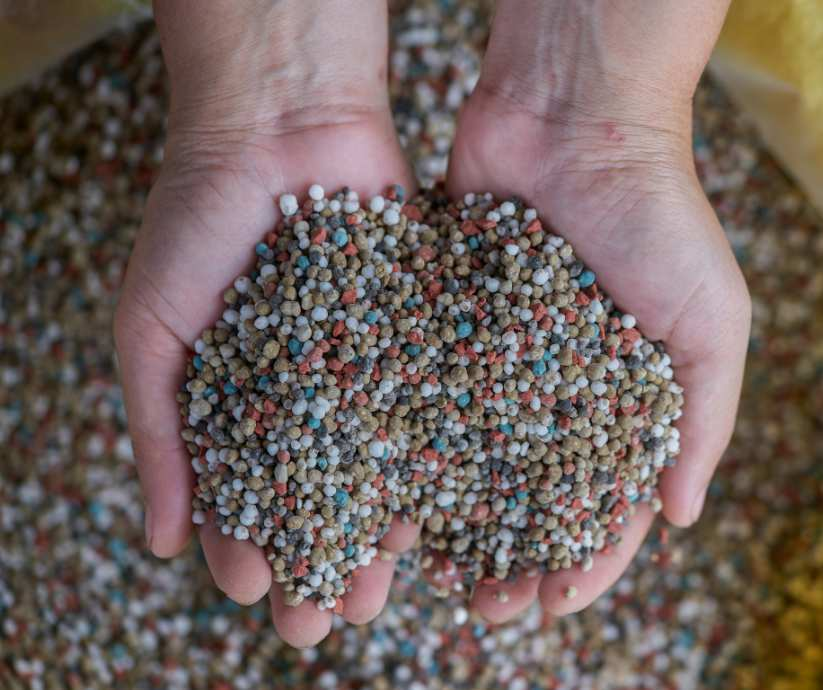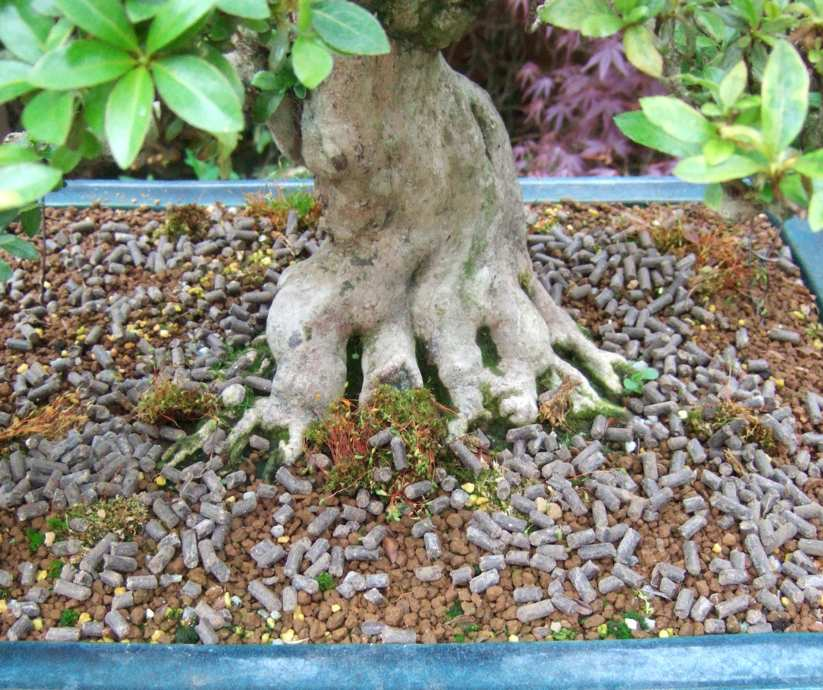Bonsai trees, with their captivating charm and distinctive allure, demand precise care to maintain their health and vibrancy. We’ll delve into the top 5 essential bonsai fertilizers, each meticulously selected to meet your beloved bonsai’s distinct requirements. This practical knowledge will guide you to make informed decisions, ensuring the flourishing of your bonsai plants, regardless of your experience level in the bonsai gardening world.
The Role of Fertilizers in Bonsai Care

Fertilizers provide essential nutrients to your bonsai, much like our bodies require nourishment. They deliver the elements nitrogen, phosphorus, and potassium. These nutrients help support the healthy root growth of your bonsai trees, leafy abundance, and flowering beauty.
Fertilizers also enhance the quality of the soil where your bonsai resides. They aid in soil water retention, ensuring your bonsai remains adequately hydrated. Moreover, they make vital nutrients easily accessible to your bonsai’s roots, mainly when confined to a small bonsai pot.
Understanding the right timing for fertilizer application is crucial. Just as we adjust our diets with the changing seasons, you should adapt the timing of fertilizer for bonsai, ensuring it gets the appropriate “nutrients” at the right time. This practice keeps your bonsai robust, lively, and aesthetically pleasing throughout the year.
By using fertilizers in harmony with the changing seasons, you can ensure your bonsai’s well-being and prevent common issues. This simple approach will help your bonsai stay healthy and beautiful for a long time.
Types of Bonsai Fertilizers
When it comes to bonsai fertilizers, there are two main categories to consider:
Organic vs. Inorganic Fertilizers:
- Organic Fertilizers: They come from natural sources like compost or fish emulsion. They’re like slow and steady nurturers, releasing nutrients slowly, which promotes gradual growth. They’re also eco-friendly, following the Earth’s rhythms.
- Inorganic Fertilizers: Chemically manufactured, these provide precise nutrient ratios (N-P-K), working quickly and allowing for exact nutrient control. For those who prefer this, inorganic bonsai fertilizer pellets are a great choice.
Slow-Release vs. Liquid Fertilizers:
- Slow-Release Fertilizers: These are like the patient gardeners who let nature unfold at its own pace. They release nutrients gradually, reducing the need for frequent applications. It’s a hands-off approach, suitable for busy gardeners.
- Liquid Fertilizers: They are the swift artists of bonsai nourishment. They’re absorbed quickly by the bonsai, offering precise nutrient control. If you prefer a more hands-on approach and like to craft the care to your bonsai’s unique needs, a liquid bonsai fertilizer can give you that flexibility.
Choosing the Right Bonsai Fertilizer
Selecting the best bonsai fertilizer doesn’t have to be tricky. You can do it step by step, keeping your specific bonsai type in mind and checking the fertilizer labels to determine how much fertilizer to use. Here’s how to make the right choice:
Match Fertilizers to Your Bonsai Species
Tailoring the right fertilizer to your specific bonsai species is akin to matching the right tool to a job. Each type of bonsai has its unique requirements. For instance, a juniper in a bonsai pot may thrive with a different fertilizer than a maple bonsai. It’s essential to check the label on your fertilizer pack to ensure that it aligns with the needs of your particular bonsai type.
Look at the N-P-K Numbers
The fertilizer packaging displays a sequence of three numbers, such as 10-5-5, representing the vital nutrients within the fertilizer – nitrogen (N), phosphorus (P), and potassium (K). These nutrients are fundamental to your bonsai’s growth. Adjusting these nutrient ratios according to your bonsai’s growth phase is essential.
For instance, during your bonsai’s active growth period, opting for a fertilizer with a higher nitrogen number can be advantageous. This thoughtful selection of fertilizer, considering these factors, can have a substantial impact on your bonsai’s well-being and growth, ensuring it prospers in its unique setting.
Consider Your Bonsai’s Age and Stage
Your bonsai’s age and stage are essential for choosing the right fertilizer. Young bonsai, in their early development, benefit from balanced fertilizers that support healthy growth and root development. As bonsai matures and enters a maintenance phase, you can adjust the nutrient balance to encourage better branching and overall refinement.
When and How to Fertilize Bonsai

Fertilizing bonsai trees is crucial for their well-being, and you can simplify the process by keeping these essential points in mind:
Seasonal Schedule
Adapting your bonsai’s fertilization routine to the changing seasons is a crucial aspect of proper care. During the active growth phases of spring and summer, your bonsai requires more frequent fertilization. This is because, during these seasons, it’s actively growing, developing leaves and branches, and, in some cases, flowering. This increased growth demands a higher supply of nutrients. Make sure to provide fertilizer more often at this time to ensure that it receives the nourishment it needs to thrive.
In contrast, as winter approaches, your bonsai enters a resting phase. During this time, its growth rate decreases significantly, and its metabolic activity slows down. As a result, it requires fewer nutrients. Reducing or even suspending fertilization during the winter allows your bonsai to conserve energy and allocate its resources toward overall health, as there is less demand for growth.
Application Techniques
- Evenly Spread: Spread the fertilizer uniformly across the bonsai soil surface to ensure balanced nutrient distribution.
- Water After: After applying the fertilizer, gently water your bonsai. This aids in transporting the nutrients to the root system.
- Avoid Overfeeding: Be cautious not to overfeed your bonsai. Follow the recommended dosage mentioned on the fertilizer label for the best results.
- Avoid Fertilizer Contact with Leaves and Trunk: When applying fertilizer, prevent it from coming into direct contact with the leaves and trunk of your bonsai. Fertilizer on the leaves can cause burns or damage, while it may harm the trunk’s delicate bark. Instead, focus on distributing the fertilizer around the soil, keeping it away from the upper parts of your bonsai.
The Top 5 Essential Bonsai Fertilizers
Now, let’s explore the topic’s core – the top 5 fertilizers that can make a remarkable difference for your bonsai. These are straightforward yet highly effective solutions to ensure the health and vibrancy of the plant.
#1 — Bonsai-specific Organic Fertilizer:
Description: These are fertilizers specifically formulated for bonsai trees, considering their unique nutrient requirements.
Benefits: Being organic, they are gentle on the bonsai, improve the soil structure, and promote microbial activity.
Examples: Cottonseed meal, rapeseed cake, or commercially prepared bonsai-specific blends.
#2 — NPK Granular Fertilizer
Description: Inorganic fertilizers with a Nitrogen-Phosphorus-Potassium (N-P-K) ratio.
Benefits: Provides essential primary nutrients. Balanced varieties ensure the bonsai gets an even spread of these critical elements.
Example: For your bonsai’s growth and health, consider a fertilizer with a higher nitrogen content in its Nitrogen-Phosphorus-Potassium (NPK) ratio, such as 10-6-6, which is suitable for outdoor bonsai. Yet, for indoor bonsais, a balanced ratio like 6-6-6 is often a good choice.
However, it’s worth mentioning that different species may have distinct preferences, so adapting the ratio to your bonsai’s requirements is a wise approach.
#3 — Organic Liquid Seaweed Fertilizer
Description: Seaweed-based fertilizers in liquid form.
Benefits: Provides trace minerals and promotes overall plant health. It is gentle on your bonsai and rich in micronutrients and growth-promoting hormones.
Examples: Maxicrop Liquid Seaweed, Neptune’s Harvest.
#4 — Slow-Release Bonsai Pellets
Description: These fertilizers release nutrients slowly over time, providing prolonged nourishment.
Benefits: Reduces the frequency of application and provides a steady nutrient supply.
Examples: Osmocote, Dyna-Gro.
#5 — Liquid Fish Emulsion Fertilizer
Description: A liquid fertilizer made from processed fish by-products.
Benefits: Provides a natural source of nitrogen and other nutrients, excellent for promoting lush, leafy growth.
Examples: Alaska Fish Fertilizer.
When using any bonsai fertilizer, it’s essential to adhere to the recommended dosage and application frequency as specified on the label. Over-fertilization can be detrimental to bonsai trees.
Furthermore, it’s worth noting that the requirements of individual bonsai tree species may vary, so researching your specific tree’s needs and seeking advice from bonsai experts or forums is always a prudent approach.
Conclusion
Fertilizing your bonsai is vital for its health and beauty. You can keep it simple by matching the right fertilizer to your bonsai’s type and growth stage. Choose between organic or inorganic and slow-release or liquid options based on your preference and the time of year. Just follow the instructions on the label, and don’t overdo it. The top 5 essential bonsai fertilizers offer versatility, ensuring your bonsai garden thrives on a straightforward path to natural beauty.
For your fertilizer and other bonsai needs, consider exploring Leaves and Soul on Amazon, where you can find various options to support your bonsai journey.
Happy gardening, and may your bonsai journey be evergreen!





0 Comments